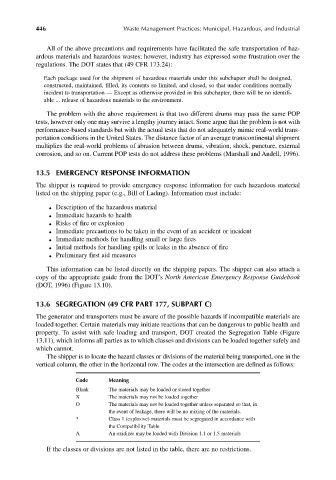Page 475 - Materials Chemistry, Second Edition
P. 475
CAT3525_C13.qxd 1/27/2005 12:30 PM Page 446
446 Waste Management Practices: Municipal, Hazardous, and Industrial
All of the above precautions and requirements have facilitated the safe transportation of haz-
ardous materials and hazardous wastes; however, industry has expressed some frustration over the
regulations. The DOT states that (49 CFR 173.24):
Each package used for the shipment of hazardous materials under this subchapter shall be designed,
constructed, maintained, filled, its contents so limited, and closed, so that under conditions normally
incident to transportation — Except as otherwise provided in this subchapter, there will be no identifi-
able ... release of hazardous materials to the environment.
The problem with the above requirement is that two different drums may pass the same POP
tests, however only one may survive a lengthy journey intact. Some argue that the problem is not with
performance-based standards but with the actual tests that do not adequately mimic real-world trans-
portation conditions in the United States. The distance factor of an average transcontinental shipment
multiplies the real-world problems of abrasion between drums, vibration, shock, puncture, external
corrosion, and so on. Current POP tests do not address these problems (Marshall and Andell, 1996).
13.5 EMERGENCY RESPONSE INFORMATION
The shipper is required to provide emergency response information for each hazardous material
listed on the shipping paper (e.g., Bill of Lading). Information must include:
● Description of the hazardous material
● Immediate hazards to health
● Risks of fire or explosion
● Immediate precautions to be taken in the event of an accident or incident
● Immediate methods for handling small or large fires
● Initial methods for handling spills or leaks in the absence of fire
● Preliminary first aid measures
This information can be listed directly on the shipping papers. The shipper can also attach a
copy of the appropriate guide from the DOT’s North American Emergency Response Guidebook
(DOT, 1996) (Figure 13.10).
13.6 SEGREGATION (49 CFR PART 177, SUBPART C)
The generator and transporters must be aware of the possible hazards if incompatible materials are
loaded together. Certain materials may initiate reactions that can be dangerous to public health and
property. To assist with safe loading and transport, DOT created the Segregation Table (Figure
13.11), which informs all parties as to which classes and divisions can be loaded together safely and
which cannot.
The shipper is to locate the hazard classes or divisions of the material being transported, one in the
vertical column, the other in the horizontal row. The codes at the intersection are defined as follows:
Code Meaning
Blank The materials may be loaded or stored together
X The materials may not be loaded together
O The materials may not be loaded together unless separated so that, in
the event of leakage, there will be no mixing of the materials.
* Class 1 (explosive) materials must be segregated in accordance with
the Compatibility Table
A An oxidizer may be loaded with Division 1.1 or 1.5 materials
If the classes or divisions are not listed in the table, there are no restrictions.

